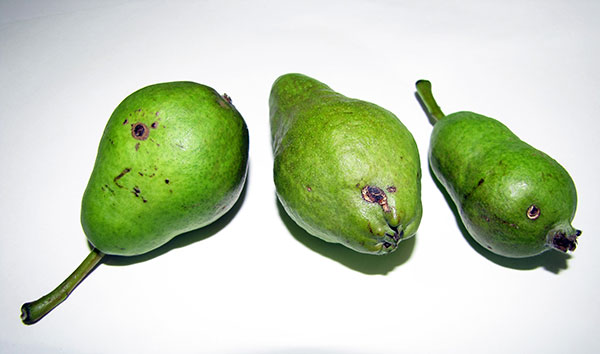Pear Scab
HOSTS
- Pear
DESCRIPTION
Pear scab is an uncommon disease in Utah due to the dry climate. It is caused by the fungus Venturia pirina.
In spring, sooty spots with a soft velvet look appear on young fruit, stems, calyx lobes, or flower petals. Young infected fruit frequently drop or are misshapen. Old fruit infections often crack open. If fruit is infected late in the season, about 2 weeks before harvest, pinpoint-size scab spots often show up in storage a month or more later.
On leaves, olive-black spots expand with leaf growth but often cause the leaf to twist abnormally. Infected twigs show small blister-like infections the size of a pinhead and develop a corky layer.
BIOLOGY
The fungus overwinters in infected leaf and fruit tissue on the orchard floor. Fallen leaves produce spores in the spring that are spread during rain to new foliage. Infections can occur all summer when rainy conditions (10-25 hr) persist.
SYMPTOMS
- Sooty spots on young fruit, stems, calyx lobes, or flower petals
- Olive-black spots on leaves
- Young infected fruit frequently drop or are misshapen
- Cracked fruit
- Pinhead-sized blister-liek infections and/or a corky layer on twigs
GENERAL MANAGEMENT
- Shred fallen leaves with a flail mower or apply nitrogen (urea) to leaves in fall to enhance decomposition of fallen leaves and make them more palatable to earthworms.
- Prune out infected twigs.
- Prevent wetting foliage in irrigation.
Information taken fromt the Pacific Northwest Plant Disease Management Handbook



